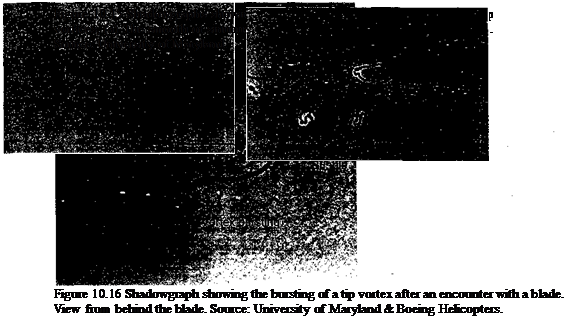Vortex Perturbations and Instabilities
 |
Gupta & Loewy (1973, 1974), and Bhagwat & Leishman (2000b). An example of a short sinuous (or Kelvin) wave is shown in Fig. 10.15(a). These types of disturbances are often neutrally stable, but can become pronounced in amplitude at older wake ages. Long wave disturbances or instabilities can sometimes result in pairing and looping of adjacent vortex filaments and can often be a source of some aperiodicity in the flow – see the experiments by Tangier et al. (1973) and Martin et al. (1999) and analysis by Gupta & Loewy (1973, 1974) and Bhagwat & Leishman (2000b). In some cases, vortex pairing may lead to a complicated aperiodic wake formation but at a subharmonic of the rotor frequency – see Leishman & Bagai (1998). Based on various experimental observations, the onset of vortex
disturbances and wake instabilities is affected by the number of blades, rotor thrust (disk loading), and overall operating conditions. Forward flight experiments with helicopter rotors in wind tunnels have shown that the tip vortices appear generally free from the regular sinuous perturbations so often noted in hovering rotor wakes, although such effects cannot be discounted unilaterally.
 |
Another type of perturbation sometimes found in rotor wakes, both in hover and forward flight, is referred to as the “cork-screw” or helical type, with examples being shown in Figs. 10.15(b) and 10.16. Here, the vortex filament tightly twists around on itself forming a very pronounced helix. These helical type perturbations appear to be common in the wakes of highly loaded propellers or tilt-rotors [see Norman & Light (1987)] rather than helicopter rotors, but they have been observed on both. In some cases, the disturbance travels along the vortex filament. In other cases, it is damped out, and the vortex returns to its regular
(periodic) form. Occasionally, the disturbance may cause the vortex to become unstable, and it may break down or burst. An example of this latter phenomenon is shown in Fig. 10.16, where vortex bursting clearly originates from the formation of a helical disturbance formed on the vortex just downstream of the blade.











